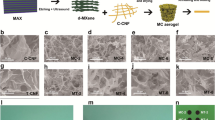Abstract
In this study, two kinds of self-supporting three-dimensional (3D) carboxymethyl cellulose (CMC) conductive sponges were fabricated and used as electrodes for lithium-ion batteries (LIBs). One was used nano-silicon graphite (Si–graphite) and the other was used nano-ferriferous oxide (Fe–graphite) as active materials. The fabrication and microstructures of two kinds of self-supporting 3D CMC conductive sponges were investigated via scanning electron microscopy and their electrochemical performances were tested when they are used as electrodes. The results show that the hybrid particles are deposited on fibrous CMC layers to form conductive sponges during the freeze-drying. Combined with those of half-battery experiments, two kinds of self-supporting 3D CMC conductive sponges used as electrodes exhibit good electrochemical performances. Moreover, most of the active materials remain encased in the CMC fiber after recycling. These novel Si–graphite and Fe–graphite CMC conductive sponged electrodes can maintain reversible capacities of 1350 and 345.8 mAh/g after 200 and 1000 charge–discharge cycles, respectively, indicating that continuous fibrous CMC conductive networks can provide novel insight into electrode materials for LIBs with enhanced electrochemical performance.









Similar content being viewed by others
References
Chabi S, Peng C, Hu D, Zhu Y (2014) Ideal three-dimensional electrode structures for electrochemical energy storage. Adv Mater 26:2440–2445
Chen SQ, Bao PT, Huang XD, Sun B, Wang GX (2014) Hierarchical 3D mesoporous silicon@graphene nanoarchitectures for lithium ion batteries with superior performance. Nano Res 7:85–94
Chen M, Liu X, Qi M et al (2017) Tailored integrated electrodes of graphene foam supported FeS2 as cathode for enhanced Li ion storage performance. Mater Technol 32:1–5
Huang ZX, Wang Y, Zhu YG, Shi Y, Wong JI, Yang HY (2014) 3D graphene supported MoO2 for high performance binder-free lithium ion battery. Nanoscale 6:9839–9845
Jeong YK, Kwon TW, Lee I, Kim TS, Coskun A, Choi JW (2014) Hyperbranched beta-cyclodextrin polymer as an effective multidimensional binder for silicon anodes in lithium rechargeable batteries. Nano Lett 14:864–870
Kim H, Hong J, Park KY, Kim H, Kim SW, Kang K (2014) Aqueous rechargeable Li and Na ion batteries. Chem Rev 114:11788–11827
Lee H, Yanilmaz M, Toprakci O, Fu K, Zhang XW (2014) A review of recent developments in membrane separators for rechargeable lithium-ion batteries. Energy Environ Sci 7:3857–3886
Lei Q, Shao Z, Wang D et al (2014) Carboxymethyl cellulose lithium (CMC-Li) as a novel binder and its electrochemical performance in lithium-ion batteries. Cellulose 21:2789–2796
Liu J, Zhang Q, Zhang T, Li JT, Huang L, Sun SG (2015) A robust ion-conductive biopolymer as a binder for Si anodes of lithium-ion batteries. Adv Funct Mater 25:3599–3605
Ma QL, Yu YF, Sindoro M, Fane AG, Wang R, Zhang H (2017) Carbon-based functional materials derived from waste for water remediation and energy storage. Adv Mater 29:1605361
Mancini M, Nobili F, Tossici R et al (2012) Study of the electrochemical behavior at low temperatures of green anodes for lithium ion batteries prepared with anatase TiO2 and water soluble sodium carboxymethyl cellulose binder. Electrochim Acta 85:566–571
Mei J, Liao T, Kou LZ, Sun ZQ (2017) Two-dimensional metal oxide nanomaterials for next-generation rechargeable batteries. Adv Mater 29:1700176
Qiu L, Shao Z, Wang D et al (2014a) Novel polymer li-ion binder carboxymethyl cellulose derivative enhanced electrochemical performance for li-ion batteries. Carbohydr Polym 112:532–538
Qiu L, Shao Z, Yang M et al (2014b) Study on effects of carboxymethyl cellulose lithium (CMC-Li) synthesis and electrospinning on high-rate lithium ion batteries. Cellulose 21:615–626
Qiu LW, Shen YD, Fan HB, Yang XW, Wang C (2018a) Carboxymethyl fenugreek gum: rheological characterization and as a novel binder for silicon anode of lithium-ion batteries. Int J Biol Macromol 115:672–679
Qiu LW, Shen YD, Wang C, Yang XW (2018b) Scanning electron microscopy analysis of guar gum in the dissolution, gelation and gel-breaking process. Polym Test 68:95–99
Tang W, Hou Y, Wang F, Liu L, Wu Y, Zhu K (2013) LiMn2O4 nanotube as cathode material of second-level charge capability for aqueous rechargeable batteries. Nano Lett 13:2036–2040
Wach RA, Kudoh H, Zhai M et al (2010) Laser flashphotolysis of carboxymethyl cellulose in an aqueous solution. J Polym Sci A Polym Chem 43:505–518
Wang J, Liu JL, Chao DL, Yan JX, Lin JY, Shen ZX (2014) Self-assembly of honeycomb-like MoS2 nano-architectures anchored into graphene foam for enhanced lithium-ion storage. Adv Mater 26:7162–7169
Yang X, Xin Y, Zhang X, Wang X, Wang C (2019) Three-dimensional carboxymethyl cellulose sponge-like ultralight electrode for lithium-ion batteries. Ionics 5:429–435
Yuan JJ, Zhang XK, Chen CH, Hao Y, Agrawal R, Wang CL et al (2017) Facile fabrication of three-dimensional porous ZnO thin films on Ni foams for lithium ion battery anodes. Mater Lett 190:37–39
Acknowledgments
We would like to express our great thanks to Natural Science Foundation of China (Grant No. 51603117), the Innovative Talents Promotion Plan in Shaanxi Province (Grant No. 2018KJXX-023), the Scientific Research Fund of Shaanxi Provincial Education Department (Grant No. 17JK0101) and the Science Association of University Talents Promotion Plan in Shaanxi Province (Grant No. 20190604) for financial support.
Author information
Authors and Affiliations
Corresponding author
Additional information
Publisher's Note
Springer Nature remains neutral with regard to jurisdictional claims in published maps and institutional affiliations.
Rights and permissions
About this article
Cite this article
Wang, C., Tian, M., Xin, Y. et al. Self-supporting three-dimensional carboxymethyl cellulose conductive sponges used as electrodes for lithium-ion batteries. Cellulose 26, 8025–8036 (2019). https://doi.org/10.1007/s10570-019-02644-1
Received:
Accepted:
Published:
Issue Date:
DOI: https://doi.org/10.1007/s10570-019-02644-1




